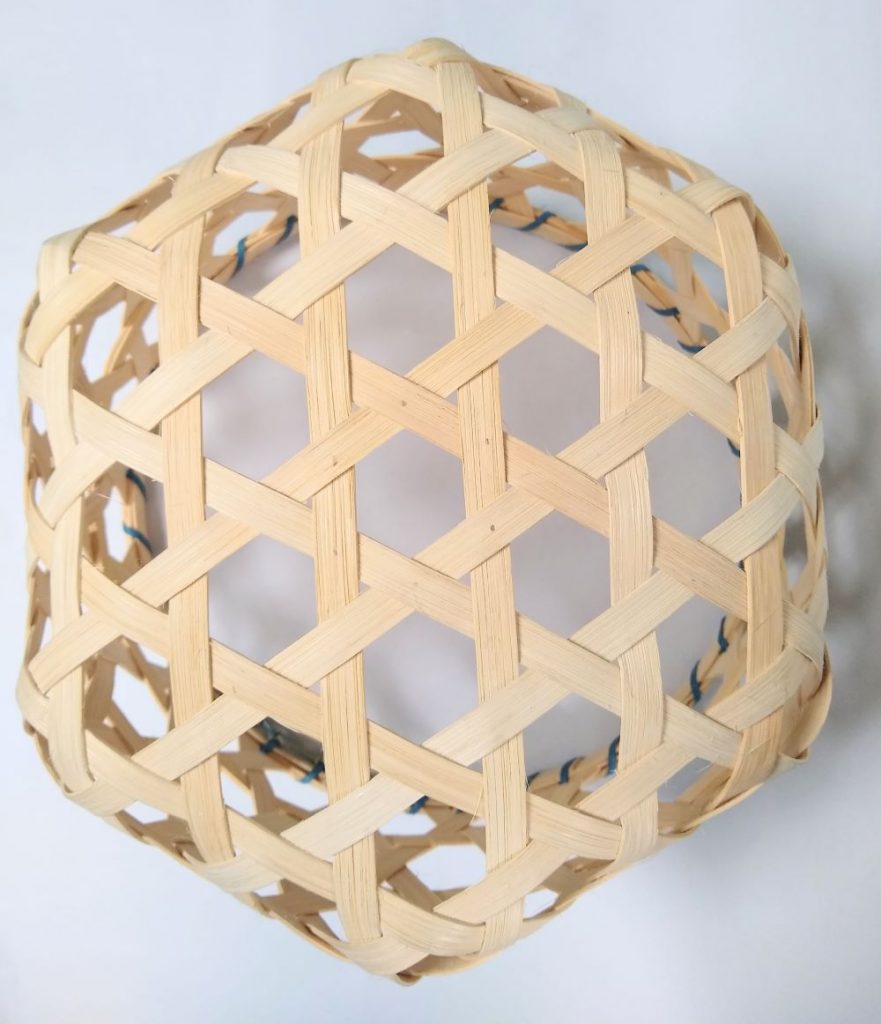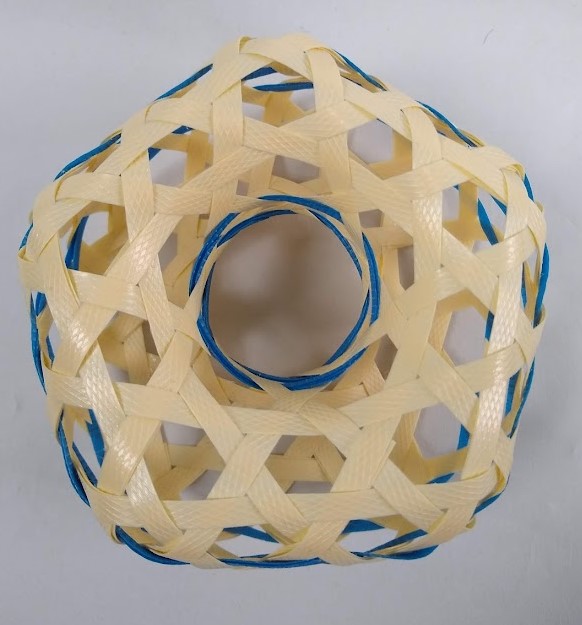For the past couple of weeks at City Lit we have been working on triaxial weaving. Unlike conventional weaving, which uses two axes at right angles to each other (warp and weft), this uses three axes, at 60º to each other – hence the name triaxial. It is also known as hexagonal weaving, but as the forms can feature different shapes, such as pentagons and heptagons, I shall call it triaxial weaving.
At every crossing point there are three strands, each of which must go over one and under another, forming a triangle where each strand is locked in place by the other two.

The simplest basket is made by weaving a hexagonal base, as in the photo above. Then you add a new horizontal weaver and create a row with pentagons at the corners and hexagons in between, which causes the sides of the basket to turn upwards. You continue adding new horizontal weavers, creating rows of hexagons up to the required height, finishing off by sandwiching the ends to make the border.

An alternative, slightly trickier method is to use a bias weave. With this, the pentagonal corners are slightly offset from the corners of the hexagonal base, and no new weavers are added. This creates a basket with vertical rather than horizontal rows of hexagons.

Then we had a go at making balls. Pentagons create corners, so the simplest balls are all pentagons. However, it’s also possible to add some rows of hexagons. Here’s a selection made in different materials.

Then there are more complex platonic solids, such as a tetrahedron and octahedron. The tetrahedron has trianges at the corners, while the octahedron has quadrilaterals.


Finally, I had a go at making a torus, or doughnut. This uses rows of heptagons to open out the form.


Mad weave
All of these forms are fairly open structures. However, there is a form of triaxial weaving where the weavers are close up against each other, with no gaps. This is called, somewhat appropriately, mad weave!
There are lots of patterns that can be created by using different coloured weavers in different combinations. For my first attempt I followed a method that involved making two separate pieces of open hexagonal weave, putting one on top of the other slightly offset, and then lacing them together with more weavers. The result is shown below.

However, the book I was using didn’t say anything about how to turn up the sides to make a 3D vessel. Luckily, after I posted my effort on Instagram, Bethany Strohm got in touch to say that she had created a video tutorial of making a mad weave basket – you can see it here.
This was extremely helpful because she explained very clearly how to identify the different shapes, which is key when working out whether you should be weaving over or under! Turning the corners and weaving up the sides was very confusing at first, as there just seemed to be a mass of strips that tended to slide and hide under each other. Also, the pattern on the base is really clear in the different colours, but on the sides the colours no longer match the pattern, so it’s even more important to recognise the shapes.
But I got there in the end!



Very interesting post, thank you. Do you have any tips for wrangling the strapping? It seems to have a mind of its own. I’m also curious about the book you were using.
Glad you enjoyed the post Peggy. The strapping is very springy and slippery, but it’s pretty indestructible, which means that I can undo and reweave to my heart’s content. 😉 I use small metal alligator clips sold in electrical and DIY shops. They come with red or black handles – the black ones seem to have a stronger grip.
The book I was using is called Hex Weave & Mad Weave by Elizabeth Lang-Harris and Charlene St John. I didn’t find it that useful or inspiring to be honest.
I’ve been collecting quite a bit of strapping in the couple of years of favouring home delivery over shopping in stores with poor ventilation. Alligator clips sound perfect with their serrated jaws, bulldog clips haven’t been useful as even with a strong grip they still tend to slip.
The indestructibility of strapping is what appeals. Unfortunately it’s impossible to know which ones are UV resistant and which aren’t.
Sorry the book isn’t that helpful, I’ll take your advice and look elsewhere.